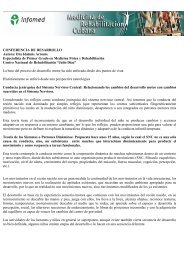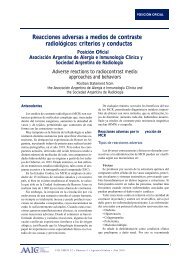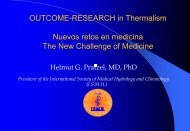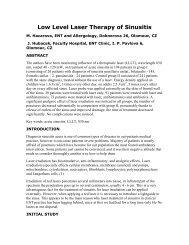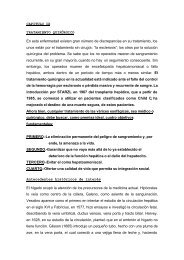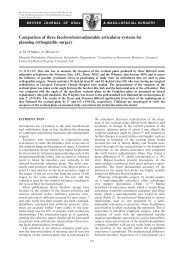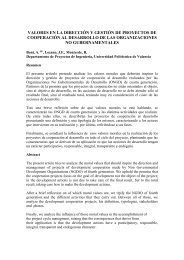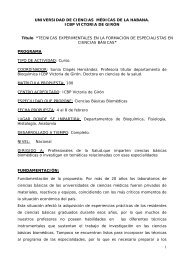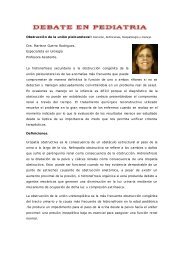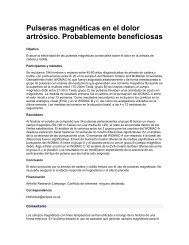pharmacology of medicinal plants and natural products
pharmacology of medicinal plants and natural products
pharmacology of medicinal plants and natural products
You also want an ePaper? Increase the reach of your titles
YUMPU automatically turns print PDFs into web optimized ePapers that Google loves.
S88<br />
S. A. DAHANUKAR et al.,<br />
improvement in the signs <strong>and</strong> symptoms, effort tolerance<br />
<strong>and</strong> NYHA class among the patients 71 .<br />
Dwivedi <strong>and</strong> Jauhari 72 studied the effects <strong>of</strong> bark stem<br />
powder <strong>of</strong> Terminalia arjuna, as compared to placebo,<br />
on angina pectoris, CCF <strong>and</strong> left ventricular mass in<br />
12 patients <strong>of</strong> myocardial infarction with angina <strong>and</strong>/<br />
or ischaemic cardiomyopathy. Their findings indicate<br />
the potential <strong>of</strong> Terminalia arjuna improving left ventricular<br />
ejection fraction <strong>and</strong> reducing left ventricular<br />
mass in coronary artery disease.<br />
5. Plants acting on respiratory system<br />
Methanolic extracts <strong>of</strong> Drymaria cordata willd <strong>and</strong><br />
Leucas lav<strong>and</strong>ulaefolia (Dronapushpi) were investigated<br />
for their effects on a cough model induced by<br />
sulfur dioxide gas in mice. Both exhibited significant<br />
anti-tussive activity, comparable to that <strong>of</strong> codeine<br />
phosphate <strong>and</strong> increasing concentrations showed<br />
better inhibition <strong>of</strong> cough 73,74 .<br />
Solanum xanthocarpum (Kantakari) <strong>and</strong> Solanum<br />
trilobatum (Alarka), the <strong>plants</strong> mentioned in Siddha,<br />
have been shown to improve various parameters <strong>of</strong><br />
pulmonary function (FVC, FEV 1<br />
, PEFR & FEF25-<br />
75%) in asthmatic subjects with mild-moderate<br />
asthma 75 .<br />
6. Anti-allergic <strong>plants</strong><br />
Ethanolic extract <strong>of</strong> Vitex negundo (Nirgundi) <strong>of</strong> was<br />
found to inhibit immunologically induced degranulation<br />
<strong>of</strong> mast cells better than that with compound<br />
40/80. It also inhibited be oedema during active paw<br />
anaphylaxis in mice 76 . Nair <strong>and</strong> Saraf 77 further studied<br />
their effects on mediator release <strong>and</strong> smooth<br />
muscle contractions <strong>of</strong> sensitized <strong>and</strong> non-sensitized<br />
guinea pig trachea using antigen <strong>and</strong> compound 48/<br />
80 respectively. The extract significantly inhibited both<br />
the initial <strong>and</strong> later sustained phases <strong>of</strong> tracheal contractions.<br />
The initial phase was primarily due to histamine<br />
release which was blocked by the extract (confirmed<br />
in guinea pig ileal studies). The latter phase<br />
was due to release <strong>of</strong> lipid mediators from arachidonic<br />
acid. Inhibition <strong>of</strong> the latter phase may be secondary<br />
to inhibition <strong>of</strong> arachidonic acid by the ethanolic<br />
extract.<br />
Arbortristoside A & C, derived from the alcoholic extract<br />
<strong>of</strong> the seeds <strong>of</strong> Nyctanthus arbortristis (Parijat) 78 ,<br />
two diterpenes, <strong>and</strong>rographolide <strong>and</strong> neoadrographolide,<br />
isolated from Andrographis paniculata 79 ,<br />
<strong>and</strong> Himachalol, a sesquiterpene alcohol, derived<br />
from the hexane soluble extract <strong>of</strong> the wood <strong>of</strong> Cedrus<br />
deodara (deodar) 80 , were found to possess significant<br />
anti-allergic activity comparable to disodium<br />
cromoglycate when tested in the experimental models<br />
<strong>of</strong> passive cutaneous anaphylaxis <strong>and</strong> mast cell<br />
degranulation in rats.<br />
Similarly, hot aqueous extract <strong>of</strong> the bark <strong>of</strong> Albizzia<br />
lebbeck (Shirish) was found to possess anti-allergic<br />
properties in experimental model <strong>of</strong> passive cutaneous<br />
anaphylaxis <strong>and</strong> mast cell stabilization activity 81 .<br />
7. Hypoglycemic <strong>plants</strong><br />
A preparation <strong>of</strong> the whole plant <strong>of</strong> Phyllanthus<br />
amarus was found to have hypoglycemic effects in 9<br />
human subjects, 4 <strong>of</strong> whom were diabetics 65 .<br />
In vitro studies carried out by Rizvi et al, 82 have shown<br />
that epicatechin, an active constituent <strong>of</strong> Pterocarpus<br />
marsupium (Vijaysar)exerted a protective effect on<br />
erythrocyte osmotic fragility, similar to insulin, but by<br />
a different mechanism <strong>of</strong> action.<br />
In streptozotocin induced diabetic rats, <strong>of</strong> the 3 important<br />
phenolic constituents <strong>of</strong> the heartwood <strong>of</strong><br />
Pterocarpus marsupium (viz.pterosupin, marsupin<br />
<strong>and</strong> pterostilbene) marsupin <strong>and</strong> pterostilbene significantly<br />
lowered the blood glucose levels <strong>and</strong> the<br />
effects were comparable to metformin 83 . The<br />
hypoglycemic efficacy <strong>of</strong> Pterocarpus marsupium<br />
has been further evaluated in a multicentric (4 centres)<br />
flexible-dose open trial in newly-diagnosed patients<br />
<strong>of</strong> non-insulin-dependent diabetes mellitus 84 .<br />
Control <strong>of</strong> blood glucose (both fasting <strong>and</strong> post-pr<strong>and</strong>ial<br />
levels) was attained in 67 <strong>of</strong> 97 patients (69%)<br />
studied in 12 weeks <strong>and</strong> the optimum dose was 2 g<br />
<strong>of</strong> the extract. HbA 1<br />
c values also decreased significantly.<br />
No significant change was observed in the<br />
mean levels <strong>of</strong> lipids.<br />
The chlor<strong>of</strong>orm eluted fraction <strong>of</strong> the petroleum ether<br />
extract <strong>of</strong> the root bark <strong>of</strong> Salacia oblonga Wall<br />
(Ponkoranti) <strong>and</strong> a fluorescent compound separated<br />
from it (by TLC) demonstrated hypoglycemic potency<br />
in rats when compared to tolbutamide 85 .<br />
The alcoholic extract <strong>of</strong> Inula racemosa<br />
(Pushkarmula) lowered blood glucose <strong>and</strong> enhanced<br />
liver glycogen in rats. However, there was no increase<br />
in plasma insulin levels nor an increase in the degree<br />
<strong>of</strong> degranulation <strong>of</strong> beta cells <strong>of</strong> pancreas. Its




